Seventeen-Year-Old Part-Time Road Construction Laborer Dies After Being Run Over by a Water Truck-Indiana

NIOSH In-house FACE Report 2001-10
Summary
On April 16, 2001, a 17-year-old male part-time road construction laborer (the victim) died when he was run over by the rear wheels of a water truck. When the victim arrived at the work site, his employer asked him to ride with him in the cab of the water truck. After riding approximately 10 minutes, the employer asked him to get out and go to the rear of the truck to check the fluid gauge on the tank. The truck continued moving forward at 3 to 5 miles per hour. A coworker, who was driving a tamping roller behind the water truck, saw the victim get off the back of the moving truck after checking the fluid gauge and walk around the truck toward the cab on the passenger side. He then saw the victim stop just before the cab, where he stooped over, leaned under the truck and was run over. The employer last saw the victim in his driver’s side mirror when the victim poked his head around the tank from his position on the ladder attached to the rear of the truck. He yelled to the victim to get down and move to the driver’s side to get ready to close an external control under the truck on the driver’s side. When the employer stopped the truck approximately 30 to 45 seconds after last seeing the victim, he looked back and saw the coworker waving and the victim lying on the road. The coworker called 911 from his cell phone. Personnel from the county sheriff’s department and county coroner’s office responded within minutes and determined that the victim had sustained fatal head injuries when he was dragged and run over by the rear wheels of the water truck. The victim was pronounced dead at the scene.
NIOSH investigators concluded that, in order to help prevent similar occurrences, employers should
- develop, implement, and enforce standard operating procedures for work performed in the proximity of vehicles and equipment. These procedures should, at minimum, prohibit workers from climbing onto, leaning under, entering or exiting moving vehicles, and detail safe procedures for working around moving vehicles and under secured vehicles
- develop, implement and enforce a comprehensive safety program which includes training in hazard recognition, including, but not limited to, hazards associated with working in proximity to vehicles and equipment, and in the avoidance of unsafe conditions
- ensure that malfunctioning equipment is removed from service until repairs have been completed
- consider contacting equipment manufacturers to enlist their help in improving equipment safety.
Introduction
On April 16, 2001, a 17-year-old male part-time road construction laborer (the victim) died when he was run over by the rear wheels of a water truck on a county road construction job. On April 20, 2001, the U.S. Department of Labor (DOL), Wage and Hour Division, notified the NIOSH Division of Safety Research (DSR) of the incident. On July 9 and 10, 2001, a DSR occupational safety and health specialist reviewed the case with the U.S. DOL Wage and Hour Division investigator and the DOL Occupational Safety and Health Administration (OSHA) compliance officer assigned to the case. The victim’s employer and coworker were interviewed, and measurements and photographs were taken at the incident site. Official investigative reports from the county sheriff’s department and the coroner’s office were reviewed during the course of the investigation.
The employer was a highway construction company that had been in operation since November 2000, normally employing 3 workers. The company was owned by two men; one was involved with the financial and administrative aspects of the business while the other worked with the road crew. The owner working with the road crew had over 20 years of experience in road construction. The company specialized in preparing road surfaces for resurfacing and was using this project as a demonstration to the county, as the county was considering entering into a contract with the company for additional work. The company owned the late 1980’s model tandem-axle water truck used on the day of the incident. The victim worked for the employer (the employer referred to here is the employer who worked along with the crew as the crew chief, hereafter referred to as the employer) in the employer’s previous business and then in the new business, over a 2 year period. He worked on a part-time basis during the summer, after school, and during school breaks. His assigned duties included assisting the employer with mechanical repairs, helping the road crew, and cleaning up the work area. The coworker who witnessed the incident had worked for the employer for 2 days. The employer did not have a written safety program and provided no formal training. The employer reported that he always supervised the victim and worked with him whenever any mechanical work was being performed. According to the employer, the youth had several years of experience working around equipment on his family’s farm and had performed mechanical work on tractors with his grandfather. This was the first fatality that had occurred during the company’s brief history.
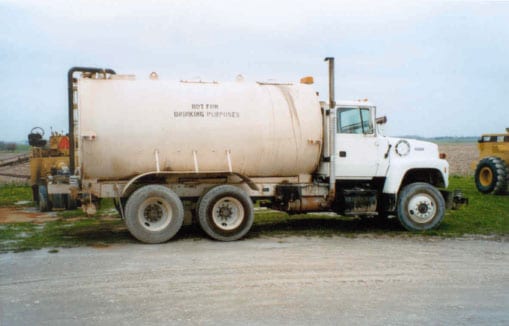
|
|
Photograph 1: This photo illustrates the water truck used the day of the incident.
|
Back to Top
Investigation
The fatal run-over incident occurred on a two-lane county road just before an intersection with another county road. At the time of the incident, the section of county road under repair was approximately one-quarter mile long and, according to the sheriff’s report, had been closed to traffic. The weather was clear and sunny and there was good visibility. The crew was in the process of applying stabilizing fluid with a water truck and compacting the roadway with a tamping roller when the victim was run over by the rear tires of the water truck.
The vehicle involved in the incident was a late 1980’s, 52,000-pound gross vehicle weight (GVW) truck with a 4,000-gallon water tank installed. Side and rear-view mirrors were present and in good condition. The tank held a patented roadbase stabilizer fluid. There were 600 to 700 gallons of stabilizer in the tank at the time of the incident.
According to the employer, control levers which were mounted inside the cab controlled the delivery of the spray. Because these in-cab controls were not functioning properly, fluid continued to dribble from the tank even after the controls were set in the “closed” position. An external device used to control the position of the main valve that regulated fluid flow was located under the truck. This device was normally used only to open the main valve at the beginning of the day’s work and to close the main valve at the end of the day’s work, but because in-cab controls were malfunctioning, it was being used at other times during the day to completely stop fluid flow. To close the main valve, someone had to crawl under the water truck from a point approximately 27 inches in front of the first set of dual wheels (see photograph 2) toward the center of the truck.
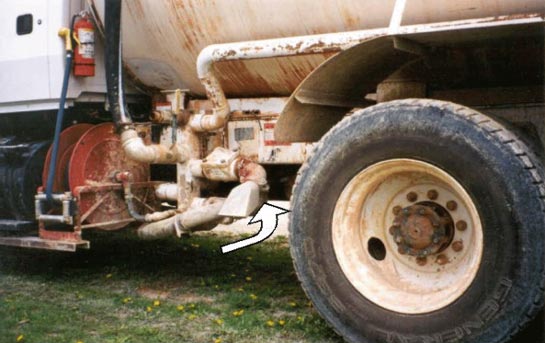 |
| Photograph 2: This photo illustrates the driver’s side of the truck. An arrow is placed in the location where the external control for the main valve was located under the truck. |
According to the employer, both he and the victim knew where the external control for the main valve was located because they had worked together rebuilding it several weeks prior to the day of the incident. Both the employer and victim had crawled under the truck, while the truck was stationary, to use the external control to turn off the main valve many times prior to the day of the incident. The employer reported that the spraying operation was normally a one-man job and whenever there was going to be a break in spraying operations, the driver stopped the truck and crawled under it to turn off the external controls for the main valve. Although the external controls could also be accessed from the passenger side of the water truck, this was not part of the usual routine, and when he and the victim had worked together in the past in spraying operations, the victim had always accessed the external controls from under the driver’s side of the vehicle.
On April 16, 2001, the road construction crew, including the employer and two workers, started the work day at approximately 8:00 a.m. They spent the earlier part of the day grinding up what was left of the worn asphalt roadway surface with an auger/grinder. One of the two employees on the site finished his part of the work and left around 1 p.m. The employer drove the water truck up and down the road spraying a stabilizer on the freshly ground surface. The remaining employee operated a tamping roller and followed the water truck, rolling and tamping the ground-up mixture of asphalt, gravel, and soil into a firm surface.
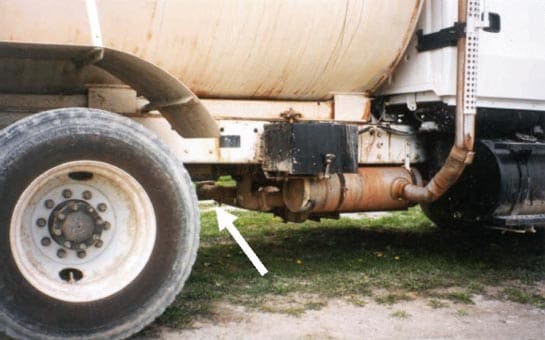 |
| Photograph 3: This photo illustrates (at arrow) the approximate location on the passenger side of the truck where the victim stooped and leaned under the truck just before he disappeared from view. |
According to the victim’s employer, the victim called him around 3:00 p.m. and asked if he could come out and help. Though the day’s work was nearly completed, the employer said he could come and help finish the job. The victim’s grandfather drove him to the site and dropped him at the water truck. The victim was wearing corrective eyeglasses, blue jeans, a tee-shirt and work boots when he arrived at the site. He did not put on a hard hat or any type of high visibility clothing before he began work, nor was one required or provided by the employer. The victim got into the cab of the water truck and talked with his employer for approximately 10 minutes. The employer asked him to get out and check the fluid gauge at the rear of the truck. As the victim exited the cab, the employer continued driving the truck forward at approximately 3 to 5 miles per hour, spraying fluid on the roadway. The victim walked along the passenger side to the rear of the truck where the gauge was located.
A coworker, who was located a short distance behind the water truck, operating a tamping roller, saw the victim climb up on a platform and up a ladder attached to the back of the truck where he appeared to be looking at the fluid lines. According to the coworker, the victim stepped down off the platform after reading a gauge while the truck was still moving, and walked to the right (the passenger side) of the water truck, toward the cab. It appeared that he was going to jump on the running board and get back into the cab when he stopped, looked at something under the truck, then stooped and leaned under the moving truck (see photograph 3) and disappeared from view. Within seconds, the coworker saw the victim’s legs extending out from the passenger side of the truck. The coworker began yelling and waving to the driver to stop. The employer continued to drive the water truck forward, at what he said was not even walking speed, spraying the stabilizer, until he reached the intersection. When he did not see the victim at the intersection where he expected him to be waiting to crawl under the truck to close the external control for the main valve, he proceeded across the intersection and pulled over on the right shoulder. As he was preparing to get out of the cab to close the external controls himself, he looked back and saw his coworker (tamping roller operator) waving his arms and heard him yelling and saw the victim lying in the road.
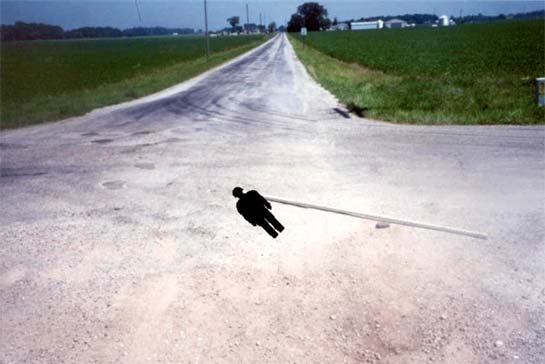 |
| Photograph 4: This photo illustrates the approximate position of the victim in the roadway after he was dragged and run over. |
As the coworker shut down his machine and called 911 with his cell phone, he saw his employer getting out of the cab. County sheriff’s department personnel received the 911 call at 3:27 p.m. and responded within minutes. They called the coroner who pronounced the victim dead at the scene.
During the course of the investigation, the employer told the NIOSH investigator that he had last seen the victim in the driver’s side mirror when the victim poked his head out from his position on the ladder or platform attached to the rear of the truck, and that he could not understand why the victim had climbed on the back of the truck as the gauge could be read from ground level. The gauge was located approximately 48 inches from the ground near the bottom of the ladder attached to the back of the truck. The employer further reported that he remembered yelling to the victim to get off the truck and get ready to close the external controls under the truck after he stopped at the intersection, and hearing the victim say “okay.”
Back to Top
Cause of Death
The coroner’s report stated the cause of death was blunt force injury to the head.
Recommendations/Discussion
Recommendation #1: Employers should develop, implement, and enforce standard operating procedures for work performed in the proximity of vehicles and equipment. These procedures should, at minimum, prohibit workers from climbing onto, leaning under, entering or exiting moving vehicles, and detail safe procedures for working around moving vehicles and under secured vehicles.
Working on or around moving vehicles on road construction sites exposes workers to hazards such as: falls from equipment; slips, trips, and falls into or under equipment; and, to run over hazards that occur as a result of workers positioning themselves where equipment/vehicle operators cannot see them (blind spots).
Employers should develop, communicate, implement and enforce safe standard operating procedures (SOPs) that address and control these hazards. At minimum, SOPs should clearly prohibit workers from climbing onto, leaning under, entering, exiting or otherwise accessing a moving vehicle. At a minimum, vehicles should be stopped, key turned off, and vehicles with automatic transmissions should be placed in park, while those with standard transmissions should be placed in the lowest gear, with a properly operating emergency brake engaged. These criteria should be met before workers are allowed to climb on/off, lean under, enter, exit or otherwise access a vehicle.
Whenever possible, projects should be engineered so that workers on foot are not assigned tasks that require them to work near moving vehicles/equipment.
When workers are assigned to tasks in the vicinity of moving vehicles/equipment on road construction sites, the employer’s SOPs should require drivers and workers on foot to:
- hold a pre-work meeting with all involved workers to outline/review the procedures to be followed for the tasks assigned;
- minimize, to the extent possible, work that must be done by workers on foot near moving vehicles;
- define blind spots and prohibit workers on foot from entering these areas (workers should be advised to look at the side mirrors; if they cannot see themselves in one of the side mirrors, they are in a blind spot);
- maintain continuous visual and verbal contact;
- require workers on foot to maintain a safe minimum distance between themselves and the moving vehicles/equipment;
- require all workers to wear appropriate high visibility safety apparel.
Working under vehicles exposes workers to hazards caused by unexpected movement. Employers should develop, communicate, implement, and enforce SOPs for safety that address and control these hazards. For work done under vehicles, SOPs for safety should include, at a minimum:
- instructions prohibiting work under or on a vehicle placed on an incline or slope;
- a pre-work meeting with all involved workers to outline/review the procedures to be followed for the tasks assigned;
- a system for communicating progress in completing the task;
- instructions on measures that are to be used to prevent unexpected movement of equipment. Steps should, at a minimum, include shutting off the engine; placing the shift lever in park and applying the parking brake, or, if a standard transmission, placing the transmission in the lowest gear and applying the parking brake; placing a warning tag on the vehicle near the controls which indicates that work is being done under the vehicle (or requiring that the driver remains in the truck in control of the keys throughout), and placing chocks (see photograph 5) in front and behind the drive axle tires;
- a system for releasing the vehicle after work is completed, which includes, at a minimum, the driver making visual and verbal contact with the worker on foot. Prior to starting the engine, the worker on foot should remove the chocks while in full view of the driver and well away from the travel path, and the worker on foot should then clear the driver to start and operate the vehicle.
A comprehensive truck inspection program developed by the Commercial Vehicle Safety Alliance (CVSA) provides additional information regarding SOPs for working under vehicles and can be found on the World Wide Web at http://www.cvsa.org/home.php. (Link updated 4/8/2013)
Recommendation #2: Employers should develop, implement and enforce a comprehensive safety program which includes training in hazard recognition, including, but not limited to, hazards associated with working in proximity to vehicles and equipment, and in the avoidance of unsafe conditions.
OSHA regulations require employers to train workers to recognize and avoid unsafe conditions that may be present in their work environments and to provide training on the regulations applicable to their work (e.g. 29 CFR 1926).1 Training should be a vital part of a highway construction company’s safety program and should address, at a minimum, all known and anticipated hazards. Employers can obtain information pertaining to preventing worker injuries from vehicles and equipment in work zones in a NIOSH document on this topic (DHHS, NIOSH) Publication No. 2001-128.2 Given the known hazards associated with highway construction (e.g. hazards of being run over by vehicles and/or equipment, exposure to hazardous chemicals, etc.), employers should provide their workers with safety training that details SOPs that are to be followed when working on or near moving vehicles and/or equipment, or under vehicles and equipment.
Recommendation #3: Employers should ensure that malfunctioning equipment is removed from service until repairs have been completed.
Controls were located inside the water truck’s cab that operated the sprayers and regulated fluid flow. According to the employer, these in-cab controls were not working properly and could only partially shut off the fluid flow. Because the in-cab controls were not working properly, the external control for the main valve located under the truck was used more frequently than normal to completely shut off the fluid flow. Under normal conditions the external controls would have been used only to open the main valve at the beginning of the day’s work and to close the main valve at the end of the day’s work. At all other times in-cab controls would have been used to intermittently control/stop fluid flow. Though using the external control/device to stop fluid flow resolved the problem of fluid loss during the course of the work day, it circumvented safety measures provided by in-cab controls that allowed fluid to be shut off at a remote safe location. Employers should remove equipment from service when in-cab controls are not working correctly, and return them to service only after they have been repaired. Repairing the in-cab controls would have reduced the number of times workers had to go under the truck. Exposure would only have occurred when controls had to be accessed twice per work shift (see recommendation #4 for relocating the external control from its location under the truck to the side of the truck). When workers are required to access external controls, SOPs detailed in recommendation #1 should be followed to protect workers.
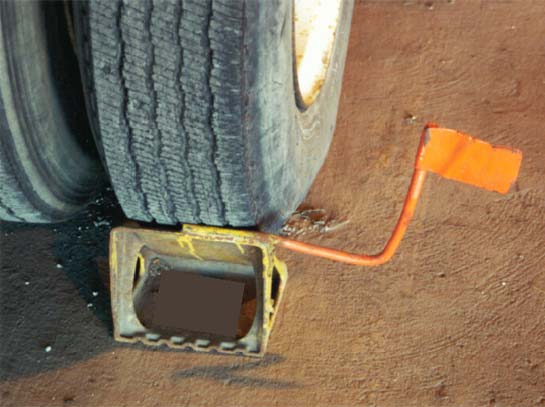 |
| Photograph 5: This photo illustrates a wheel chock with a flag. A metal flag welded onto a metal chock could allow for greater visibility. (Photograph courtesy of George Swartz, CSP) |
Recommendation #4: Employers should consider contacting equipment manufacturers to enlist their help in improving equipment safety.
Employers should contact equipment manufacturers to obtain information regarding ways to improve the safety of equipment used on their work sites. In this incident, an older model water truck was used. The external control for the main valve on the water tank was located under the truck and a worker had to crawl under the truck at least twice each day, once to open and once to close the main valve. The external control for the main valve could be relocated from its position under the truck to the side of the truck, thus eliminating the need for workers to routinely crawl under the truck to close the main valve. The location of the fluid gauge for the water tank could also be addressed. An electronic gauge similar to a gasoline gauge could be installed inside the truck’s cab. Relocating the gauge inside the cab, thereby removing the need for workers on foot to walk near or climb onto the truck to read the gauge, would reduce worker exposure to hazards. Engineering controls should be used whenever possible to eliminate exposure and should be supplemented with safety SOPs and effective safety training.
Back to Top
References
- Code of Federal Regulations 2000th edition. 29 CFR 1926.21 (b)(2). Safety Training and Education. U.S. Printing Office, Office of the Federal Register, Washington, D.C.
- NIOSH [2001]. Building safer highway work zones: measures to prevent worker injuries from vehicles and equipment. U.S. Department of Health and Human Services, Public Health Service, Centers for Disease Control and Prevention, National Institute for Occupational Safety and Health, DHHS (NIOSH) Publication No. 2001-128.
In-house Reports
Contact Us:
- National Institute for Occupational Safety and Health (NIOSH)
- Centers for Disease Control and Prevention
- 800-CDC-INFO
(800-232-4636)
TTY: (888) 232-6348 - New Hours of Operation
8am-8pm ET/Monday-Friday
Closed Holidays - Contact CDC-INFO
